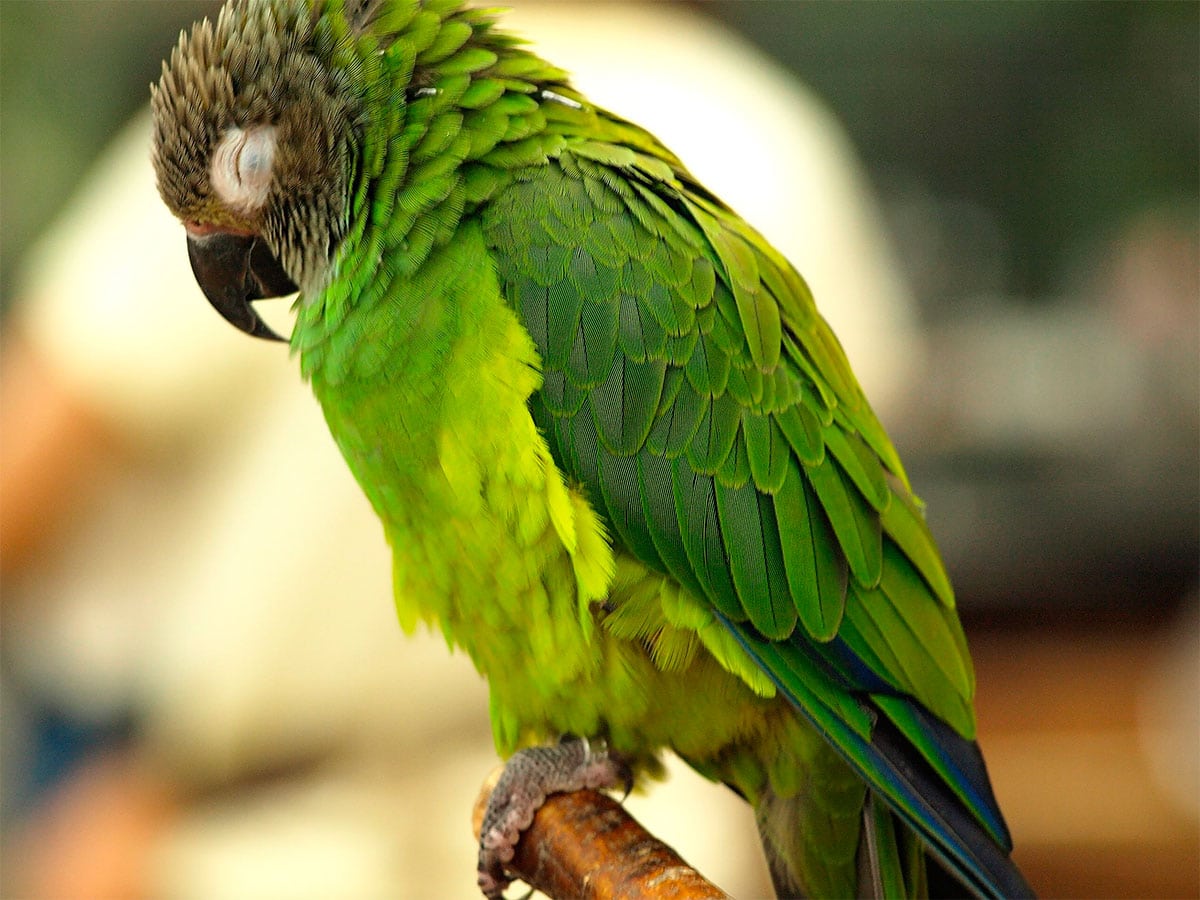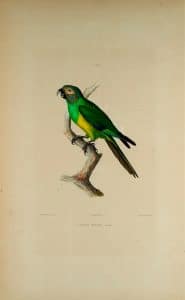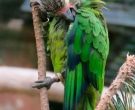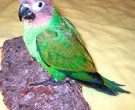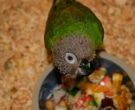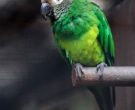Content
|
|---|
Description:
Of 25-30 cm.. length and a weight between 95-115 g.
The head of the Dusky-headed Parakeet (Aratinga weddellii) is greyish Brown, with off blue stripes that give it a scaly appearance. The upperparts are green, the feathers of the nape they have yellowish margins (some banks in the mantle), the back and Hip with Brown centers, giving an appearance of Brown altogether. The scapulars with varying between Brown and green edges; the minor, large and medium-sized inner coverts green grass with paler green margins; the outer and the primary coverts are dark blue. Primary and secondary mostly blue with vane outer Green or green margins toward the vane external in the primaries; very dark (almost black) the Tips. Underwing-coverts green: underside of the flight feather opaque gray. Top of the chest pale green with turquoise suffusion; belly and undertail-coverts pale yellowish green, greener on the flanks. Upper, the tail green, Blue towards the tip: undertail, opaque gray.
The bill shiny black; cere pinkish grey; wide area orbital off-white; irises yellowish white; legs dark gray.
Both sexes similar.
The immature are like adults but with the irises darker.
- Sound of the Dusky-headed Parakeet.
Habitat:
Video – "Dusky-headed Parakeet" |
|---|
They inhabit in humid jungle, semi-wet, swamps, involved swamp forest and stubble, until 500 metres in Colombia and exceptionally 750 metres in Bolivia. Its preferred habitats are the forests and marshes and flooded forests in swampy areas. Also in the remnants of forest in humid savannah and cleared areas with patches of remnant forest. Also observed in coffee and sugarcane plantations; apparently rarely fly over the dense forest. Usually, in pairs or in small groups, but flocks of up to 75 reported individuals where food is plentiful.
Reproduction:
It nests in trees and palms of marshy or riparian areas, between June and August. They also used the cups of dead Palm trees and termite nests.
Four nests observed in Leticia, Colombia, between 4 and 15 metres in height. Birds incubating in the month of February in Colombia. Bird in reproductive condition in the month of August in Bolivia. Observed breeding from June to September in Loreto, eastern peru; from April to July in the Mato Grosso.
A normal start is of 3 to 5 eggs and both parents feed the chicks.
Food:
Its diet consists of seeds, fruit, flowers, berries, as well as insects and their larvae found in decaying trees and stumps.
Distribution:
Its distribution ranges from the southeast of Colombia, east of Ecuador and Peru to the East of Bolivia and West of Brazil.
Apparently Nomad in some parts of the distribution. In general common, even in partially deforested areas, and perhaps increase due to clearing and fragmentation of dense forest.
Conservation:
State of conservation ⓘ |
||
|---|---|---|
 Minor Concern ⓘ
(UICN)ⓘ
Minor Concern ⓘ
(UICN)ⓘ
| ||
• Red List category of the UICN current: Least concern
• Population trend: Growing
The size of the world population Dusky-headed Parakeet It has not been quantified, but this species is described as common (Stotz et to the. (1996)).
This species is suspected that it has been lost between the 15 and the 17,7% of its suitable habitat within its range over three generations (21 years) based on a model of deforestation of the Amazon (Soares-Filho et to the., 2006, Bird et to the. 2011). Given the susceptibility of this species to the hunting or trapping, It is suspected that its population may decrease in around the 25% in three generations.
"Dusky-headed Parakeet" in captivity:
Not common in captivity, but in the past was part of the international trade. They are common in cultivation areas, for this reason they are common in homes of peasants.
The Dusky-headed Parakeet is not known for its ability to mimic the speak human, but they are nevertheless birds very fun, kind and loving – provided that they have been hand reared and socialized properly. They are not as active and noisy as other species of parrots, they only emit sounds, not too high, when excited.
wonderful pets. His charming personality makes them good pets for children. They are not demanding, they spend happy hours playing with their favorite toys but still enjoy human company very much.
They are relatively easy to raise. They may have several broods per year; But, good husbandry practice stipulates that they should not be allowed to have more than two or three clutches to allow for their rest. The size of Sunset is of 3 to 4 eggs, they are incubated for a few 23 days. Both parents take care of the young.. The chicks leave the nest after a few 50 days.
In the wild, according to sources, females have been estimated can live up to 25 years. Its longevity in captivity It has not been studied in detail. It has been observed a muscle aging in wild animals.
Alternative names:
– Dusky-headed Parakeet, Dusky Conure, Dusky headed Parakeet, Dusky Parakeet, Dusky-headed Conure, Weddell’s Conure (English).
– Conure de Weddell, Conure à tête sombre, Perriche de Weddell, Perruche de Weddell (French).
– Weddellsittich, Weddell-Sittich (German).
– Aratinga-de-cabeca-escura, aratinga-de-cabeça-suja, jandaia-de-cabeça-azulada, jandaia-de-cara-suja, periquito-de-cabeça-suja (Portuguese).
– Aratinga Cabecifusca, Perico Canoso, Periquito de Cabeza Gris, Perico cabezagris(español).
– Loro canoso, Perico Canoso, Cotorra cabecigris, Cotorra cabeciparda (Colombia).
– Cotorra de Cabeza Oscura, San Pedrito, Lorito cabeza gris (Peru).
– Perico cabecioscuro (Ecuador).
– Tarechi (Bolivia).
– Ipií (Chimane).
– Bambaorito (I ingano).
– Sacara (Cofán.).
– Butuquiria (Macuna).
scientific classification:
– Order: Psittaciformes
– Family: Psittacidae
– Genus: Aratinga
– Scientific name: Aratinga weddellii
– Citation: (Deville, 1851)
– Protonimo: Conurus Weddellii
Dusky-headed Parakeet images:
Sources:
– Avibase
– Parrots of the World – Forshaw Joseph M
– Parrots A Guide to the Parrots of the World – Tony Juniper & Mike Parr
– Birdlife
– Photos:
(1) – Dusky-headed Conure or Weddell’s Conure (Aratinga weddellii) in captivity. Kobe Kachoen By merec0 (originally posted to Flickr as Kobe Kachoen (32)) [CC BY 2.0], via Wikimedia Commons
(2) – A Dusky-headed Parakeet at Jurong Bird Park, Singapore By Sham Edmond [CC BY 2.0], via Wikimedia Commons
(3) – Dusky-headed Conure or Weddell’s Conure (Aratinga weddellii) By Steve Beger [CC BY-SA 2.0], via Wikimedia Commons
(4) – Dusky-headed Conure or Weddell’s Conure (Aratinga weddellii) By en:user:Jhwodchuck (http://en.wikipedia.org/wiki/Image:DuskyConure.jpg) [GFDL, GFDL or CC-BY-SA-3.0], via Wikimedia Commons
(5) – Aratinga weddellii – black-headed conure – Dusky-headed conure – dusky-headed conure Florin Feneru – Flickr
(6) – Ilustración Dusky-headed parakeet by Biodiversity Heritage Library – Flickr
– Sounds: (Xeno-canto)
